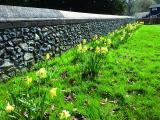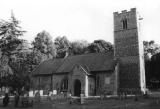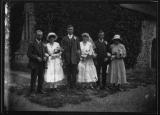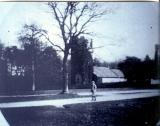|
 
St. Mary's Church in Santon Downham is set in a most tranquil spot on the edge of the forest at the end of the large village green. The Domesday Book notes the existence of a church in the village, most probably wooden and replaced by the present one. The Nave was begun in the 12th century and built towards the east culminating in the chancel which was finished during the 13th century. The tower was built between 1460 and 1500 as a result of bequests made by various members of local families. Interesting to note on the north side of the tower about two thirds up there is a yellow brick that marks the spot, reputedly, of the level at which the sand came to rest in the famous sand storm of 1668.
This section contains several pages about the church and its births and burials.
Church Details The Tower Church Life
The daffodils in the photograph above first flowered in 2013 and were planted around the church wall by the Sayer family in memory of Vera's mother Annie Royal.
|
|
 
 
This little church contains some fascinating anomalies: next to the north porch outside, there is evidence of an additional, or most probably, an earlier Trinity chapel; there is an arch filled with knapped flint and to the east a very well preserved piscina, the little niche above the door in the porch is off centre, indicating that the much thicker east wall of the porch was orginally the west side of this chapel, most probably destroyed during the Reformation. Above the south doorway there is a carved stone panel depicting what could be a wolf (symbolising evil) devouring the tree of life,which, indestructible sprouts from the wolf's tail - symbolic of the Resurrection? (Similar depictions may be found on two capitals in the north transept of Ely Cathedral and on the Norman tympanum of the Tree of Life at Wordwell, 10 miles from Santon Downham). High up in the south wall of the nave is an arched opening, having in it the remains of a mediaeval scroll painting, but it bears no relation to anything else in the church.
Within is a 13th or 14th century font and an early 14th century screen, crude and heavy in design but with a curious roughly cut double arch in one panel of the dado, possibly a primitive confessional. The altar cross, candlesticks and the processional cross all in wood are modern and were made by a local forester. There are some fragments of mediaeval glass in the South chancel window but otherwise all the stained glass is Victorian except for the 1952 window in the south wall of the chancel by Harcourt Doyle.
The memorials relate to the various landowners and their families connected with the village, notably the Wrights from the 17th and 18th centuries, through the Cadogans to the last 'squire', Colonel Edward Mackenzie who died in 1929.
There is a large memorial inside to Lieutenant Colonel The Honourable Henry Cadogan who was killed at the Battle of Vittoria in Spain during the Peninsular War.
Outside in the graveyard, near the gate is to be found the remains of a mediaeval churchyard cross, from the time when a single cross or crucifix commemorated all souls.
Simon Knott has a website which features suffolk churches including Santon Downham and All Saints
The Corpus of Romnesque Sculpture also feature the church
Contact and Service Details
|
|
 
 
The Register of Baptisms, Marriages and Burials dates from 1579 and is complete from that date.
Photograph of Mr.& Mrs. Carter’s wedding by Mr. John Fuller. and the Church in 1880
|
|
|
|
|
|
|
|
|
|
|
|
|
Copyright 2016 TJKSoftware,Icehouse Media,Sally McIrvine ~ designed & maintained by
TJKSoftware

